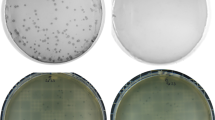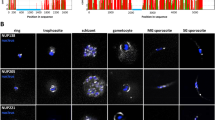Abstract
The tail of the enzyme RNA polymerase II is responsible for integrating the diverse events of gene expression in eukaryotes and is indispensable for life in yeast, fruit flies, and mice. The tail features a C-terminal domain (CTD), which is comprised of tandemly repeated Y1-S2-P3-T4-S5-P6-S7 amino acid heptads that are highly conserved across evolutionary lineages, with all mammalian polymerases featuring 52 identical heptad repeats. However, the composition and function of protozoan CTDs remain less well understood. We find that malaria parasites (genus Plasmodium) display an unprecedented plasticity within the length and composition of their CTDs. The CTD in malaria parasites which infect human and nonhuman primates has expanded compared to closely related species that infect rodents or birds. In addition, this variability extends to different isolates within a single species, such as isolates of the human malaria parasite, Plasmodium falciparum. Our results indicate that expanded CTD heptads in malaria parasites correlates with parasitism of primates and provide the first demonstration of polymorphism of the RNA polymerase II CTD within a single species. The expanded set of CTD heptads feature lysine in the seventh position (Y1-S2-P3-T4-S5-P6-K7), a sequence only seen otherwise in the distal portion of mammalian polymerases. These observations raise new questions for the radiation of malaria parasites into diverse hosts and for the molecular evolution of RNA polymerase II.



Similar content being viewed by others
Abbreviations
- CTD:
-
Carboxy-terminal domain or C-terminal domain
References
Allison LA, Moyle M, Shales M, Ingles CJ (1985) Extensive homology among the largest subunits of eukaryotic and prokaryotic RNA polymerases. Cell 42:599–610
Aravind L, Iyer LM, Wellems TE, Miller LH (2003) Plasmodium biology: genomic gleanings. Cell 115:771–785
Barron-Casella E, Corden JL (1992) Conservation of the mammalian RNA polymerase II largest-subunit C-terminal domain. J Mol Evol 35:405–410
Bartolomei MS, Halden NF, Cullen CR, Corden JL (1988) Genetic analysis of the repetitive carboxyl-terminal domain of the largest subunit of mouse RNA polymerase II. Mol Cell Biol 8:330–339
Bienkiewicz EA, Moon WA, Woody RW (2000) Conformation of the RNA polymerase II C-terminal domain: circular dichroism of long and short fragments. J Mol Biol 297:119–133
Carty SM, Greenleaf AL (2002) Hyperphosphorylated C-terminal repeat domain-associating proteins in the nuclear proteome link transcription to DNA/chromatin modification and RNA processing. Mol Cell Proteomics 1:598–610
Chapman AB, Agabian N (1994) Trypanosoma brucei RNA polymerase II is phosphorylated in the absence of carboxyl-terminal domain heptapeptide repeats. J Biol Chem 269:4754–4760
Chapman RD, Conrad M, Eick D (2005) Role of the mammalian RNA polymerase II C-terminal domain (CTD) nonconsensus repeats in CTD stability and cell proliferation. Mol Cell Biol 25:7665–7674
Chapman RD et al (2007) Transcribing RNA polymerase II is phosphorylated at CTD residue serine-7. Science 318:1780–1782
Chapman RD, Heidemann M, Hintermair C, Eick D (2008) Molecular evolution of the RNA polymerase II CTD. Trends Genet 24:289–296
Corden JL (1990) Tails of RNA polymerase II. Trends Biochem Sci 15:383–387
Corden JL (2007) Transcription: Seven ups the code. Science 318:1735–1736
Dacks JB, Marinets A, Ford DW, Cavalier-Smith T, Logsdon JM Jr (2002) Analyses of RNA polymerase II genes from free-living protists: phylogeny, long branch attraction, and the eukaryotic big bang. Mol Biol Evol 19:830–840
Egloff S, Murphy S (2008) Cracking the RNA polymerase II CTD code. Trends Genet 24:280–288
Egloff S et al (2007) Serine-7 of the RNA polymerase II CTD is specifically required for snRNA gene expression. Science 318:1777–1779
Giesecke H, Barale JC, Langsley G, Cornelissen AW (1991) The C-terminal domain of RNA polymerase II of the malaria parasite Plasmodium berghei. Biochem Biophys Res Commun 180:1350–1355
Guo Z, Stiller JW (2005) Comparative genomics and evolution of proteins associated with RNA polymerase II C-terminal domain. Mol Biol Evol 22:2166–2178
Howe KJ (2002) RNA polymerase II conducts a symphony of pre-mRNA processing activities. Biochim Biophys Acta 1577:308–324
Iyer LM, Anantharaman V, Wolf MY, Aravind L (2008) Comparative genomics of transcription factors and chromatin proteins in parasitic protists and other eukaryotes. Int J Parasitol 38:1–31
Li WB, Bzik DJ, Gu HM, Tanaka M, Fox BA, Inselburg J (1989) An enlarged largest subunit of Plasmodium falciparum RNA polymerase II defines conserved and variable RNA polymerase domains. Nucleic Acids Res 17:9621–9636
Liao SM, Taylor IC, Kingston RE, Young RA (1991) RNA polymerase II carboxy-terminal domain contributes to the response to multiple acidic activators in vitro. Genes Dev 5:2431–2440
Licatalosi DD et al (2002) Functional interaction of yeast pre-mRNA 3′ end processing factors with RNA polymerase II. Mol Cell 9:1101–1111
Litingtung Y et al (1999) Growth retardation and neonatal lethality in mice with a homozygous deletion in the C-terminal domain of RNA polymerase II. Mol Gen Genet 261:100–105
Liu P, Greenleaf AL, Stiller JW (2008) The essential sequence elements required for RNAP II carboxyl-terminal domain function in yeast and their evolutionary conservation. Mol Biol Evol 25:719–727
Meininghaus M, Chapman RD, Horndasch M, Eick D (2000) Conditional expression of RNA polymerase II in mammalian cells. Deletion of the carboxyl-terminal domain of the large subunit affects early steps in transcription. J Biol Chem 275:24375–24382
Mizzen CA et al (1996) The TAF(II)250 subunit of TFIID has histone acetyltransferase activity. Cell 87:1261–1270
Nonet M, Sweetser D, Young RA (1987) Functional redundancy and structural polymorphism in the large subunit of RNA polymerase II. Cell 50:909–915
Perkins SL (2008) Molecular systematics of the three protein-coding genes of malaria parasites: corrobative and new evidence for the origins of human malaria. Mitochondrial DNA 19:471–478
Perkins SL, Sarkar IN, Carter R (2007) The phylogeny of rodent malaria parasites: simultaneous analysis across three genomes. Infect Genet Evol 7:74–83
Phatnani HP, Greenleaf AL (2006) Phosphorylation and functions of the RNA polymerase II CTD. Genes Dev 20:2922–2936
Proudfoot NJ, Furger A, Dye MJ (2002) Integrating mRNA processing with transcription. Cell 108:501–512
Schroeder SC, Schwer B, Shuman S, Bentley D (2000) Dynamic association of capping enzymes with transcribing RNA polymerase II. Genes Dev 14:2435–2440
Stiller JW, Cook MS (2004) Functional unit of the RNA polymerase II C-terminal domain lies within heptapeptide pairs. Eukaryot Cell 3:735–740
Stiller JW, McConaughy BL, Hall BD (2000) Evolutionary complementation for polymerase II CTD function. Yeast 16:57–64
Volkman SK et al (2007) A genome-wide map of diversity in Plasmodium falciparum. Nature Genet 39:113–119
Zorio DA, Bentley DL (2004) The link between mRNA processing and transcription: communication works both ways. Exp Cell Res 296:91–97
Acknowledgments
This work was supported by Grant AI 52390 from the National Institutes of Health to K. W. D. and Medical Scientist Training Program Grant GM07739 and the Paul and Daisy Soros Fellowship to S. P. K. We thank John Stiller for his critical reading of the manuscript. We thank the Malaria Research and Reference Reagent Resource Center (MR4), Dr. X. Su of the NIAID for P. falciparum isolate gDNAs, and Mr. Bryan Falk of the American Museum of Natural History for extracting the P. yoelii, P. berghei, and P. vinckei species and subspecies gDNAs.
Author information
Authors and Affiliations
Corresponding author
Rights and permissions
About this article
Cite this article
Kishore, S.P., Perkins, S.L., Templeton, T.J. et al. An Unusual Recent Expansion of the C-Terminal Domain of RNA Polymerase II in Primate Malaria Parasites Features a Motif Otherwise Found Only in Mammalian Polymerases. J Mol Evol 68, 706–714 (2009). https://doi.org/10.1007/s00239-009-9245-2
Received:
Revised:
Accepted:
Published:
Issue Date:
DOI: https://doi.org/10.1007/s00239-009-9245-2




